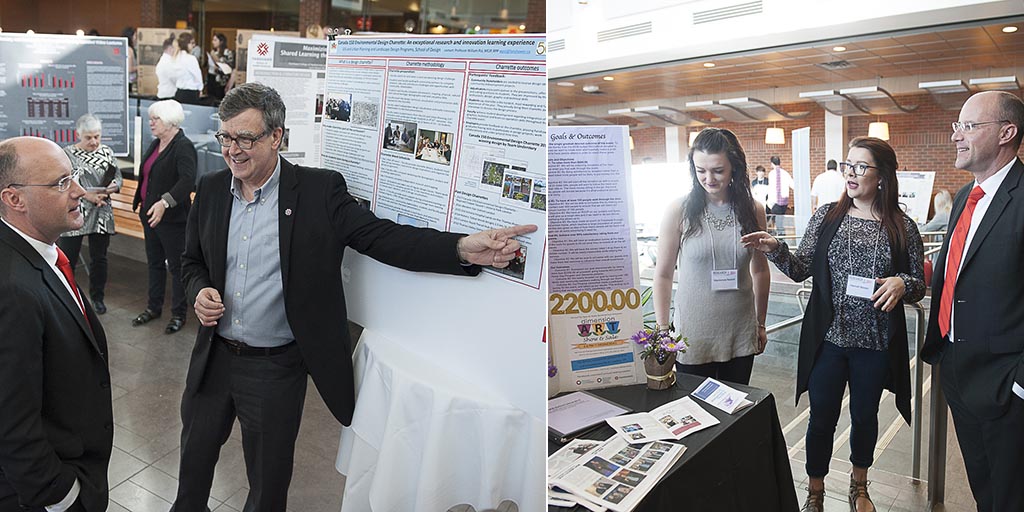Fanshawe's Research and Innovation Day a success
 CREDIT: JOHN SING, PHOTOGRAPHER FOR FANSHAWE'S CORPORATE COMMUNICATIONS
CREDIT: JOHN SING, PHOTOGRAPHER FOR FANSHAWE'S CORPORATE COMMUNICATIONSStudents, staff, faculty and community members such as William Pol (left), Mackenzie Nesbitt (middle) and Hannah Niesen (right) presented their projects to Mayor Matt Brown during Fanshawe's Research and Innovation Day on March 21.
Fanshawe students, faculty, staff and some community members celebrated the work of a variety of different groups who presented their findings at the Research and Innovation Day on March 21.
The one-day showcase was a time for members of the Fanshawe community, as well as some outside individuals, to come together to see the research and innovation activity happening at the college, said Stephanie Hernandez, outreach and events co-ordinator in the Centre for Research and Innovation.
On top of the student and community groups, there were 11 faculty projects that were also on display.
According to Hernandez, there were a few components of the day, including the students competing for a prize in four different categories including industry, business, community and scholarship sections.
Mayor Matt Brown and Fanshawe president Peter Devlin were on hand taking in the hard work the participants were showcasing.
The projects themselves were categorized not only by their focus, but also “their projected impact of the student research projects”, Hernandez said.
The day also included a keynote speech by one of the co-founders of GamerLink, a mobile app that lets gamers connect online for a better experience while interacting with others.
The startup was developed by two Fanshawe alumni, who won money at a previous Research and Innovation Day, which helped further enhance their startup.
Hernandez, who’s been running the Research and Innovation Day for the past four years, and the lead co-ordinator for the past three, had positive thoughts about how the event went.
“Every year is different, there’s different elements, we get a different breath of projects so it’s always interesting to see and I find it’s continuingly a learning process,” Hernandez said.
According to Hernandez, the thing she noticed that was a change this year, compared to previous ones, was the increase in approved projects showcased at the event.
“It’s been a great upswing on the amount of activities that are happening at Fanshawe and the amount that we can showoff and showcase,” Hernandez said.
Hernandez said that although there is no specific cut off mark of the amount of projects that can be included each year, there needs to be enough space for everyone, saying this year the event, which was in the James A. Colvin Atrium on campus, was roughly at full capacity.
Hernandez also said that the applicants do go through a vetting process before being selected for a spot to showcase their projects. This helps to make sure each project fits well into one of the categories, and that there are no overlaps of projects or too many in one category, and to make sure there’s enough work that “constitutes an innovation or a research project”.
The process includes the applications and projects being reviewed by a committee, including the dean of the Centre for Research and Innovation Dan Douglas, to simply make sure they are “meritorious enough to showcase”.
A few projects to highlight included the Synthetic Cannabinoid as Cancer Cell Therapeutic, which is about the therapeutic effect of synthetic cannabinoids on breast cancer cell lines, according to the event’s program pamphlet.
Another project was DimensionArt Show and Sale in partnership with McCormick Home Day Program, which according to the program, looked at the need for dementia services within the community, and a third project was from Fanshawe faculty members, titled Canada 150 Environmental Design Charrette. This looked at an environmental redesign process of a community project, according to the program.
In terms of funding, projects are able to receive $100 worth of help, which can help put together large posters for example, while the Fanshawe Student Union (FSU) has also been a strong advocate for the day as well helping in terms of funding and sponsoring the program.
FUS president Carlie Forsythe, who was judging for the second year, this time in the community sectioned projects, was enthusiastic regarding her experience.
“Judging is just a fantastic experience, you actually get to see what a lot of our students are researching, what projects they’re working on, a lot of them are capstone for their programs, so it’s actually quite a big deal and I think the research is finally starting to get on par with almost university level,” Forsythe said. “It’s actually really awesome to see and I love supporting that kind of event.”
Forsythe was able to see a number of projects, including a table based on feminism and one from the bachelor of interior design program who also touched upon some sustainability with their design and research concepts. She also enjoyed those that focused specifically on sustainability, but expressed the event itself was overall an important one.
“I think in kind of the time that we’re in right now, I think supporting research and innovation is extremely important. It helps keep our competitive advantage up as well among other colleges and universities because we’re kind of in the middle of all of them right now, so I think that definitely helps and I think the quality of assignments that we’re seeing and quality of presentations that we’re seeing is steadily increasing.”














